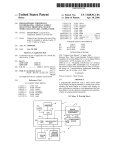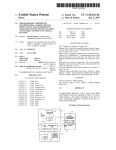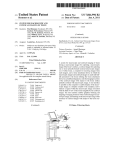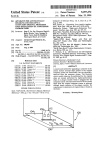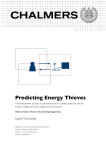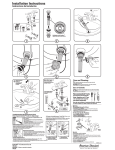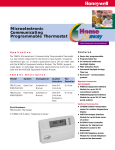Download Programmable thermostat employing a fail safe real time clock
Transcript
US007185825B1 (12) (54) United States Patent (10) Patent N0.: Rosen (45) Date of Patent: PROGRAMMABLE THERMOSTAT 6,344,861 B1 EMPLOYING A FAIL sAEE REAL TIME 6,478,233 B1 2/2002 Naughton (Continued) (76) Inventor: Howard Rosen, Lyncroft Road, Hampstead, Quebec (CA) H3X 3E3 Notice: FOREIGN PATENT DOCUMENTS 33341176 M1985 DE Subject to any disclaimer, the term of this - patent is extended or adjusted under 35 (Connnued) U.S.C. 154(b) by 241 days. (21) .. (22) Filed: (51) OTHER PUBLICATIONS Appl NO _ 10/875 579 . ADI, “Leopard User Manual,” 93 pages, 2001. , (Continued) Jun. 24, 2004 Int_ CL G05B 23/19 G05B 23/32 F25B 17/00 (2006.01) G05B 15/00 (2006.01) Primary ExamineriMarc Norman (74) Attorney, Agent, or FirmiMarc E. Hankin; Hankin Patent Law (2006.01) (2006.01) (57) 62/231_ 700/276 _ _ _ ’ . . Aprogml.nmallle thefmostat for °§~mr°11t1?1g spew? con‘thnTo?' mg equ1pmen rece1ves power rom e equ1pmen. e thermostat has an 1nteract1ve mterface for user program Field of Classi?cation Search ................ .. 236/94, ming, a temperature Sensor and a processor including: a 236/1 C, 46 R, 46 C; 62/157, 231; 700/275, central processing unit; a memory for storing program and 700/276 (56) ABSTRACT . (52) us. Cl. ...................... .. 236/46 C; 236/94; 62/157; (58) Mar. 6, 2007 11/2002 Shah CLOCK (*) US 7,185,825 B1 See application ?le fOr complete Search hiSIOI'YReferences Cited data information, a real time clock and a non volatile random access memory. A control program stored in the memory causes the real time clock to periodically read its current time and date information into the non-volatile RAM. Upon restart after an outage, the time and date information stored in the non-volatile RAM is read into the real time clock to US. PATENT DOCUMENTS 4,224,615 A 9/1980 PenZ 4,267,966 A * 5/1981 Neel et al. .............. .. 236/46 A Operation Accordingly, the need for providing a backup 4 431 134 A * 2/1984 Hendricks et a1‘ ______ __ 236/46 R poWer source, such as a battery or a supercap, is eliminated. 4,818,428 A ‘"1989 sdlwble 1* 31 5’086’385 A 5’l70’935 A provide an acceptable time and date basis for resuming 21:35:59.?2111:5111’;51211131111113.3511 21215110111515? 2/1992 Launey_et al' 12/1992 Fédersplel for example, WW VB. The output of the receiver is used to periodically update the time and date in the real time clock 5,460,327 A * 10/1995 H111 et al. ............... .. 236/46 R Such that, even after an Outage, the real time Clock Will be 5,818,428 6,059,195 6,192,282 6,285,912 accurate. If the receiver is not operating for some reason after an outage, then the real time clock Will still be set from the non-volatile RAM. A A B1 B1 6,330,806 B1 10/1998 5/2000 2/2001 9/2001 Elsenbrandt et a1~ Adams et a1. Smith et al. Ellison et a1. 12/2001 Beaverson et a1. 16 Claims, 5 Drawing Sheets 31 NON-VOLATILE RAM ‘ 30 50 as \ REAL TIME CLOCK \13 9\ CPU r wwvs RECEIVER US 7,185,825 B1 Page 2 US. PATENT DOCUMENTS 6,595,430 B1 6,621,507 B1 2003/0040842 A1* 2003/0121652 A1* 7/2003 Shah 9/2003 Shah 2/2003 Poth ......................... .. 700/275 7/2003 Carey et a1. .............. .. 165/238 FOREIGN PATENT DOCUMENTS EP W0 W0 0985994 WO 97/11448 WO 97/39392 3/2000 3/1997 10/1997 OTHER PUBLICATIONS Business Wire, “MicroTouch Specialty Products Group to Capital iZe on Growing Market for Low-Cost Digital Matrix Touchscreens,” p1174 (2 pages), Jan. 6, 1999. DeKoven et al., “Designing Collaboration in Consumer Products,” 2 pages, 2001. Honeywell, “W7006A, Home Controller Gateway User Guide,” 31 pages, Jul. 2001. “High-tech options take hold in new homesi200-08-28iDallas Business Journal,” http://biZiournalscom!dallas/stories/2000/08/ 28/focus4, 3 pages, dated Aug. 28, 2000, printed Aug. 19, 2004. “Product ReviewiPhilips Pronto Remote Control,” http:// homethreaterhi?com/volume 6 2/philipsprontoremotecontrol.html, 5 pages, dated May 1999, printed Aug. 20, 2004. http://www.cc.gatech.edu/computing/classes/cs6751 94 fall/2roupc/ climate-2/node 1 .html, “Contents,” 53 pages, printed Sep. 20, 2004. “HAI Company Background,” http://www.homeauto.com/ AboutHAI/abouthai main.htm, 2 pages, printed Aug. 19, 2004. Cardio Manual, available at http://www.secant.ca/En/Documenta tion/Cardio2é-Manual.pdf, Cardio Home Automation Inc., 55 pages, printed Sep. 28. 2004. “RC X10 Automation Forum: Control your Heating and Cooling Freudenthal et al., “Communicating extensive smart home func System with Pronto(1/1),” http://www.remotecentral.comlcgi tionality to users of all ages: the design of a mixed-initiative binlmboardlrc-x 1 0/thread.c~i? 12, 2 pages, dated Apr. 23, 1999, multimodal thermostat-interface,” pp. 34-39, Mar. 12-13, 2001. printed Aug. 20, 2004. Honeywell News Release, “Honeywell’s New Sysnet Facilities Integration System For Boiler Plant and Combustion Safety Pro cesses,” 4 pages, Dec. 15, 1995. * cited by examiner U.S. Patent Mar. 6, 2007 Sheet 2 0f 5 NON-VOLATILE RAM 3 °\ REAL TIME CLOCK CPU FIG. 2 US 7,185,825 B1 U.S. Patent Mar. 6, 2007 Sheet 3 0f 5 FROM SUITABLE POINT IN CONTROL PROGRAM PRE DETERMINED TIME ELAPSED SINCE UPDATE’? SEND CURRENT RTC TIME AND DATE T0 NGN-VOLATILE RAM RETURN TO SUITABLE POINT ‘IN CONTROL PROGRNW FIG. 3 US 7,185,825 B1 U.S. Patent Mar. 6, 2007 Sheet 4 0f 5 FROM SUITABLE POINT IN RESTART OF CONTROL PROGRAM 42 l SEND CURRENT RTC TIME AND DATE TO NON-VOLATILE RAM 1 RETURN TO SUITABLE POINT m CONTROL PROGRAM FIG. 4 US 7,185,825 B1 U.S. Patent Mar. 6, 2007 Sheet 5 0f 5 US 7,185,825 B1 31 \ NON-VOLATILE RAM * 33 \ K50 WWVB RECEIVER 30 \ REAL TlME CLOCK \ \13 CPU FIG. 5 US 7,185,825 B1 1 2 PROGRAMMABLE THERMOSTAT EMPLOYING A FAIL SAFE REAL TIME CLOCK pipes Will not take place. If, for example, self suf?cient pets are left behind for a feW days, a higher temperature, say 60° F., might be selected. The choice is Within the purvieW of the user. Similarly, in hot climates, a user might select a tem perature of, say, 90° F. or even higher to effect substantial savings in the cost of energy for cooling, but not so high as to cause damage to items in the space. Again, if, for example, pets are left behind, a more comfortable tempera ture of 80° F. or so might be selected. FIELD OF THE INVENTION This invention relates to the art of thermostats and, more particularly, to a programmable thermostat incorporating a fail safe real time clock and Which does not require battery Some programmable thermostats incorporating a vacation mode of operation also provide for storing the date and even time of day that the occupant(s) of the conditioned space Will return such that operation of the space conditioning equip or other backup device in case of a poWer failure. BACKGROUND OF THE INVENTION Thermostats have been used for many years as tempera ture sensitive sWitches Which control heating and/ or cooling equipment for conditioning a space in Which a thermostat, or a temperature sensor connected to the thermostat, is placed. ment may automatically earlier be returned to a normal mode of operation in anticipation of the return of the occupant(s), thus ensuring a comfortable temperature in the conditioned space at that time. Most commonly, poWer to a programmable thermostat is In the Well knoWn manner, a simple thermostat can be adjusted to establish a temperature set point such that, When the temperature in the conditioned space reaches the set 20 point, the thermostat interacts With the heating and/or/ cooling equipment to take suitable action to heat or cool the conditioned space as may be appropriate for the season. Modern thermostats, Which take advantage of the ongoing rapid advances in electronic technology and circuit integra supplied from the controlled space conditioning equipment, and either a battery or very high capacity capacitor (“super cap”) provides backup poWer to “ride out” equipment poWer failure (“outage”) until poWer is restored. HoWever, these are not fail safe expedients. Batteries must be changed at intervals to ensure that the thermostat Will continue to hold 25 tion, have many features Which provide more precise super vision of the heating and/or cooling equipment to achieve its time and setting throughout an outage, but this mainte nance task is often ignored or folloWed sporadically. Super caps, on the other hand, are susceptible over time to devel more economical and more comfortable management of the oping leakage Which greatly diminish their charge-storing temperature of a conditioned space. Many modern thermo capacity; i.e., they may develop a resistance across their stat include a real time clock, a memory and a data processor 30 to run a process control program stored in the memory to plates Which is suf?ciently loW (even though the resistance value might ordinarily thought to be very high in other circuits) that a charge stored during normal operation dis accurately measure the temperature of a temperature sensor disposed in the conditioned space and to send control signals to the heating and/or cooling equipment to closely control the temperature of the conditioned space. The use of pro 35 grammed thermostat systems permits anticipating and mini miZing hysterisis or overshoot of the temperature in the conditioned space. In addition, the program can specify different set points at different times of the day and days of the Week and may also include a “vacation” mode Which 40 employs different set points When the conditioned space is not occupied for an extended period. Most such modern thermostats are programmable by a user. Typically, a programmable thermostat incorporates a tactile user interface With various buttons (or representations 45 charges to an insuf?cient level during a poWer outage before poWer is restored. In either instance, the real time clock loses its current time and date values. This state, particularly if the outage occurs While the thermostat is operating in the vacation mode, can have drastic consequences and, at best, can be a signi?cant inconvenience. If, upon the restoration of poWer, the ther mostat enters a programming mode (as if the thermostat Were neWly installed and because all programming and/or current time and date information has been lost), the nor mally conditioned space Will not be heated or cooled as the case may be such that the reasons set forth above for using the vacation mode Will not be met. Even if the thermostat has of buttons on a touch screen) to be touched in a precise the capability of restarting in its operational mode at the time sequence to program set points (Which may vary With the of the outage (e.g., if the processor memory includes non volatile random access memory for storing changeable time of day and day of the Week) for programmable time periods and Which may include both normal and vacation modes. The programming sequence may be folloWed on a information such as set up and mode data and can restart the 50 display, typically a liquid crystal display, and When the programming steps have been completed, the thermostat is sWitched the immediately desired operational mode. The purpose of a vacation mode is to maintain the temperature of a conditioned space Which Will be unoccu 55 pied for a period at a value Which Will substantially loWer the cost of energy to heat/cool the conditioned space but Which ensures that the temperature Will not fall into a range at 60 OBJECTS OF THE INVENTION separate program from normal operation is entered by Whatever procedure is provided in a given thermostat. The vacation mode may include one or more periods a day for Which set point temperatures may be entered. In cold cli mates, a heating temperature set point Will be selected by a user to be suitable, say 45° F., such that freeZing of Water for example, in the vacation mode, the system Will not correctly anticipate the return of occupants and thus Will not necessarily earlier resume normal operation to render the space comfortable by the time the occupants return. It Will therefor be apparent to those skilled in the art that it Would be highly desirable to provide a fail safe real time clock in a programmable clock, particularly a thermostat incorporating a vacation mode of operation. Which damage to the premises, for example, freeZing pipes, Will occur. The operation of programmable thermostats in the vacation mode is straightforward and Well knoWn. A real time clock at, say, some default date), the thermostat real time clock Will not have the correct time or date such that, 65 It is therefore a broad object of this invention to provide a thermostat Which incorporates a fail safe real time clock. It is another broad object of this invention to provide a thermostat Which does not require a backup source of energy for continuing thermostat status during an outage. US 7,l85,825 B1 4 3 It is a more speci?c object of this invention to provide a thermostat having a real time clock and a non-volatile random access memory in Which the current time and date are periodically read from the real time clock into the random access memory such that, in the event of an outage, the real time clock and its support circuitry in a second the last time and date previously stored is recovered from the DESCRIPTION OF THE PREFERRED non-volatile random access memory upon the restoration of EMBODIMENT(S) FIG. 5 is a block diagram of a portion of the processor component of the thermostat particularly shoWing aspects of exemplary embodiment of the invention poWer to reset the real time clock in anticipation of resuming operation in the mode running at the time of the outage. Referring ?rst to FIG. 1, an exemplary thermostat In an alternative and supplementary aspect, it is a more includes a processor 1, a touch screen 2 and a temperature speci?c object of this invention to also periodically updatei sensor 5 Which is disposed in a conditioned space 4. It Will be understood that the processor 1 and the touch screen 2 are and also initialiZe after an outageithe real time clock by a signal from the National Institute of Standards and Tech nology or other source of precision time. typically situated in a common housing (not shoWn). The sensor 5 may also be situated in the common housing or remotely as shoWn, all as very Well knoWn in the art. The SUMMARY OF THE INVENTION common housing is usually, but not necessarily, placed in the Brie?y, these and other objects of the invention are achieved, in a programmable thermostat having a real time clock by periodically, during normal poWered operation, 20 storing the current time and date in a non-volatile random access memory such that, in the event of an outage, the last time and date previously stored is recovered from the program information and also, via an input/output unit (I/O non-volatile random access memory and used for subse quent operations When poWer is restored. This provides an acceptable reset of the clock Which Will only be off current time by an amount represented by the period betWeen the last update and the return of poWer. The real time clock can subsequently be set to the current time in the usual manner. Thus, the need for backup poWer, such as a battery or a supercap, is eliminated. In one embodiment, the real time clock is also periodically updated by a signal from the National Institute of Standards and Technology (or other source of precision time). Accordingly, the real time clock is alWays close to the correct time during normal operation, and When the thermostat is recovering from a poWer failure, the real time clock Will be su?iciently close to effectively permit resumption of normal or vacation mode operation as in the simpler embodiment and Will also automatically promptly be set to the correct current time. If the precision 25 30 unit) 10, a touch pad 11 and a liquid crystal display (LCD) 12 Which constitute the touch screen 2. The memory 8 may include a read-only part Which is factory-programmed and a random-access part Which stores data subject to change during operation. A settable real time clock 13 is used to keep time in the thermostat to facilitate diverse operations, such as different temperature set points (desired tempera tures), during different periods of the day cycle. An analog to-digital converter 27 (Which may not be required in all 35 systems) serves to convert any analog information received by the I/O unit 10 to digital information Which is suitable for use by the CPU 9. Temperature information from the sensor 5 and output signals to a space conditioning (heating and/or cooling) unit 3 pass through the I/O unit 10 under control of the CPU 9. 40 Those skilled in the art Will understand that if the corre spondents external to the processor 1 communicating With the CPU 9 are all digital in nature (e.g., if the temperature sensor 5 incorporates its oWn analog-to-digital converter and sends a digital representation of temperature to the processor time signal is unavailable for some reason, the real time clock Will still be reset by the information store in the non-volatile random access memory. DESCRIPTION OF THE DRAWING conditioned space 4. Thus, those skilled in the art Will understand that the block diagram of FIG. 1 is very general in order to best explain an exemplary environment in Which the invention can be practiced as Will be discussed beloW. The processor 1 includes a central processing unit (CPU) 9 in communication With a memory 8 for storing data and 45 1), then the I/O unit 10 may only constitute simple sWitching circuits. The subject matter of the invention is particularly pointed out and distinctly claimed in the concluding portion of the speci?cation. The invention, hoWever, both as to organiZa tion and method of operation, may best be understood by reference to the folloWing description taken in conjunction With the subjoined claims and the accompanying draWing of Thus, in the usual manner during normal operation, the temperature sensor 5 sends an electrical signal (e.g., if the sensor 5 is a simple thermistor, a resistance value; several 50 of the temperature Within the conditioned space 4 Which the processor can compare against a previously entered set point to determine if control signals need to be sent to the space Which: FIG. 1 is a block diagram of an exemplary space condi tioning system incorporating a thermostat With backup types of temperature sensors are Widely used) representative conditioning equipment 3. For example, if the temperature 55 poWer, in case of an outage, supplied from a battery or in the conditioned space 4 is found to be too loW When operation is in the heating mode, the processor 1 signals the space conditioning equipment 3 to circulate, through ducts 6, 7, air from/to the conditioned space 4 Which is heated by supercap in accordance With the prior art; FIG. 2 is a block diagram of a portion of the processor component of the thermostat particularly shoWing aspects of FIG. 3 is a process How chart illustrating a part of the the space conditioning equipment before return to the con ditioned space. This heating phase continues until the sensor 5 indicates that the space is noW too hot (or approaching too hot) With reference to the current set point such that the thermostat control program by Which an updating operation is carried out according to the practice of the invention; ment 3 to cease the heating function, all as very Well knoWn the thermostat clock and its support circuitry in a ?rst 60 exemplary embodiment of the invention; FIG. 4 is a process How chart shoWing a part of the control program restart When poWer has just been restored after an outage according to the invention; and processor 1 sends signal(s) to the space conditioning equip 65 in the art. In a cooling mode, a counterpart procedure is folloWed. Those skilled in the art Will understand that the control process typically includes such re?nements as antici US 7,185,825 B1 5 6 pation, hysterisis accommodation, fan control, etc. Which are value stored in the non-volatile RAM 31. Accordingly, the acknowledged, but are not directly relevant to the invention. In accordance With the prior art, poWer to the processor 1 time and date Will be off no more than the period of the outage plus the period since the time and date Were last updated before the outage as described above. Most outages are relatively short term, a feW minutes to perhaps an hour, is conventionally supplied from the space conditioning equipment 3 via a line 30 through an isolation diode 33. In the event of a poWer outage, poWer is supplied from a such that it Will be apparent that a restart With a time and date backup battery 31 (or a very high capacity capacitor “super resident in the real time clock Which is only this limited cap” 32) to “ride out” equipment poWer failure until poWer amount sloW Will permit resumption of operation With little problem. As previously mentioned, this is of particular is restored. HoWever, these are not fail safe expedients. Batteries must be changed at intervals (and often are not) to ensure that the thermostat (or at least the clock) Will continue to operate during a poWer failure. Supercaps are susceptible importance When the thermostat is operating in the vacation mode. FIG. 5 illustrates a second exemplary embodiment of the invention. In this embodiment, a Wireless receiver 50 is to developing leakage Which greatly diminish their charge storing capacity; i.e., they may develop a resistance across the plates su?iciently loW that a charge stored during normal operation discharges during an outage before poWer is tuned to a source of precision time such as WWVB Which operates at 60 khZ. Such receivers are Well knoWn in the art and may be implemented in small integrated circuits Which can readily be incorporated into a thermostat. For example, a single chip WWVB receiver is available from Micro restored. Attention is noW directed to FIG. 2 Which is a block diagram of the clock 13, modi?ed according to a ?rst exemplary embodiment of the invention, and the compo nents With Which it communicates. As previously described, the clock 13 provides real time information to the CPU 9 to facilitate the timely institution of or stopping of diverse operations. The clock 13, in accordance With the present Analog Systems of Espoo, Finland, and is designated by part 20 from the receiver 50 is a once per second data set of the exact invention includes a real time clock module 30 Which is an olf-the-shelf integrated circuit component and a small non volatile random access memory (RAM) 31, such as a ?ash RAM or electrically eraseable random access memory (ee prom). Such memories, of Which there are various types, are 25 characterized in that they Will hold their contents inde?nitely upon a poWer failure, but may, during normal operation, be 30 tion, the memory 8 may include a non-volatile RAM section 32 Which eliminates the need for the separate non-volatile RAM 33. As a practical matter, as the state of the art of circuit integration progresses, most or all the components of a programmable thermostat according to the invention may time (Which can be adjusted to a time Zone) and date. This information is used to periodically update the time and date information running in the real time clock 30. It Will noW be understood that the embodiment of the invention shoWn in FIG. 5 Will normally keep, and resume after an outage, precision time from a suitable source such as WWVB. In addition, if WWVB is not being received (because it is off the air, there is interference, etc.), then the rewritten essentially limitlessly in the same manner as a volatile RAM Which, hoWever, does lose its contents as a result of a poWer loss. It may be noted, as represented by the dashed communication line 33, that, in practicing the inven number MAS9178 in data sheet DA9178.000. The output 35 clock is still fail safe because this embodiment Will then operate in the manner of the embodiment shoWn in FIG. 2 and the process flow charts of FIGS. 3 and 4. While a Wireless source of precision time has been discussed, it should be noted that precision time (from, for example, the National Institute of Standards and Technol ogy) is also available on the Internet such that it is contem plated that the source 50 can receive its time signals via that medium. In another embodiment of the invention, for use in areas 40 be incorporated as a single con?gurable and programmable Where the Wireless reception of time and date signals is is connected. HoWever, it is a feature of the invention that no source of backup poWer, such as a battery or supercap, is reliable (or When the Internet, noW very reliable, is used as the communications medium), then the non-volatile RAM 31 may be omitted and the sub-processes shoWn in FIGS. 3 and 4 need not be carried out. Rather, the real time clock 30 Will be constantly (or as often as desired) updated from the external precision time source and, in the event of an outage and restart, the real time clock 30 Will be promptly accu required. rately set. integrated circuit or in a very feW chips. The thermostat, including the real time clock 30, is normally conventionally poWered, via line 35 and an isola tion diode 36, from the equipment to Which the thermostat 45 Referring also noW to the process How chart of FIG. 3, the relevant portion of the control program normally running in the CPU 9 is described. In accordance With the invention, at some suitable point in the loop of the control program, an inquiry is made (step 40) as to Whether a predetermined period since the time and date information in the real time clock 30 Were last stored has been exceeded. (Merely by 50 55 Way of example, the predetermined period might be one ditioning equipment comprising: Would eliminate the need for step 40.) If not, the control program. Referring noW to FIG. 4, it Will be seen that, in the event of a poWer failure and then a restart after poWer has been restored, the restart procedure of the control program includes resetting the real time clock from the time and date ?cations of structure, arrangements, proportions, the ele ments, materials, and components, used in the practice of the invention Which are particularly adapted for speci?c envi ronments and operating requirements Without departing from those principles. What is claimed is: 1. A programmable thermostat for controlling space con hour, but it could be as often as every time the control program runs through the routine shoWn in FIG. 3 Which program continues. HoWever, if the predetermined period has been exceeded, the stored time and date is updated (step 41) from the real time clock before continuing the control Thus, While the principles of the invention have noW been made clear in an illustrative embodiment, there Will be immediately obvious to those skilled in the art many modi 60 A) means coupling suitable poWer for energiZing said thermostat from said space conditioning equipment to said thermostat; B) an interactive interface for a user to enter programming information into said thermostat; 65 C) a temperature sensor for providing an electrical signal indicative of the temperature of a conditioned space in Which the temperature sensor is situated; US 7,185,825 B1 8 7 10. The thermostat of claim 5 Which includes a vacation D) a processor, said processor including: mode of operation. 11. A programmable thermostat for controlling space 1) a central processing unit; 2) a ?rst memory coupled to said central processing unit for storing program and data information; and conditioning equipment comprising: 3) an input/output unit including: for receiving said electrical signal therefrom; and A) means coupling suitable poWer for energiZing said thermostat from said space conditioning equipment to said thermostat; b) a control output coupled to the space conditioning B) an interactive interface for a user to enter programming a) a sensor input coupled to said temperature sensor equipment for issuing control signals thereto; 4) a real time clock; information into said thermostat; 10 5) a non-volatile random access memory; and 6) a control program stored in said ?rst memory directing: a) said real time clock to periodically read its current time and date information into said non-volatile memory; and 1) a central processing unit; 2) a ?rst memory coupled to said central processing unit for storing program and data information; and b) upon restart after a loss and then return of poWer 3) an input/output unit including: from said space conditioning equipment, read the time and date information stored in said non volatile memory into said real time clock. 2. The thermostat of claim 1 in Which said non-volatile random access memory is included in said ?rst memory. 3. The thermostat of claim 2 Which includes a vacation a) a sensor input coupled to said temperature sensor 20 for receiving said electrical signal therefrom; and b) a control output coupled to the space conditioning equipment for issuing control signals thereto; 4) a real time clock; and 5) a receiver adapted to receive current time and date mode of operation. 4. The thermostat of claim 1 Which includes a vacation C) a temperature sensor for providing an electrical signal indicative of the temperature of a conditioned space in Which the temperature sensor is situated; D) a processor, said processor including: 25 mode of operation. 5. The thermostat of claim 1 Which further includes a receiver adapted to receive current time and date informa tion from an external source of the current time and date, said receiver being coupled to said real time clock such that the time and date information thereof is updated from said receiver. 6. The thermostat of claim 5 in Which said receiver receives Wireless signals from said external source. 30 7. The thermostat of claim 6 Which includes a vacation 35 information from an external source of the current time and date, said receiver being coupled to said real time clock such that the time and date informa tion thereof is updated from said receiver. 12. The thermostat of claim 11 in Which said receiver receives Wireless signals from said external source. 13. The thermostat of claim 12 Which includes a vacation mode of operation. 14. The thermostat of claim 11 in Which said receiver receives signals via the lntemet from said external source. 15. The thermostat of claim 14 Which includes a vacation mode of operation. mode of operation. 8. The thermostat of claim 5 in Which said receiver receives signals via the Internet from said external source. 9. The thermostat of claim 8 Which includes a vacation mode of operation. mode of operation. 16. The thermostat of claim 11 Which includes a vacation











